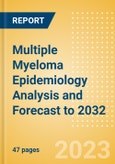In the 8MM, the diagnosed incident cases of MM are expected to increase from 80,305 cases in 2022 to 95,349 cases in 2032, at an Annual Growth Rate (AGR) of 1.87%. In 2032, the US will have the highest number of diagnosed incident cases of MM in the 8MM, with 35,307 diagnosed incident cases, whereas Spain will have the fewest diagnosed incident cases with 3,517 cases. In the 8MM, the diagnosed prevalent cases of MM are expected to increase from 272,948 cases in 2022 to 305,020 cases in 2032, at an AGR of 1.18%. The publisher epidemiologists attribute the increase in the diagnosed incident cases and diagnosed prevalent cases of MM to a certain extent with the moderately rising trend in the incidence of MM in the 8MM, combined with underlying demographic changes in the respective markets.
Scope
- This report provides an overview of the risk factors, comorbidities, and the global and historical epidemiological trends for MM in the eight major markets (8MM: US, France, Germany, Italy, Spain, UK, Japan, and Urban China).
- The report includes a 10-year epidemiology forecast for the diagnosed incident and diagnosed prevalent cases of MM. The diagnosed incident cases of MM are segmented by age (18 years and older), sex, by type (asymptomatic and symptomatic), by stage at diagnosis (R-ISS stage I, R-ISS stage II, and R-ISS stage III), by stem cell transplant (SCT) eligibility (eligible and ineligible), and by genetic and surface markers [t(4;14)(p16;q32), t(14;16)(q32;q23), t(14;20) (q32;q12), t(11;14)(q13;q32), and deletion 17p].
- The diagnosed prevalent cases of MM are segmented sex, by stage at diagnosis (R-ISS stage I, R-ISS stage II, and R-ISS stage III), and by genetic and surface markers [t(4;14)(p16;q32), t(14;16)(q32;q23), t(14;20) (q32;q12), t(11;14)(q13;q32), and deletion 17p].
- This epidemiology forecast for MM is supported by data obtained from peer-reviewed articles and population-based studies.
- The forecast methodology was kept consistent across the 8MM to allow for a meaningful comparison of the forecast diagnosed incident and diagnosed prevalent cases of MM across these markets.
Reasons to Buy
The Multiple Myeloma epidemiology series will allow you to -- Develop business strategies by understanding the trends shaping and driving the global MM market.
- Quantify patient populations in the global MM market to improve product design, pricing, and launch plans.
- Organize sales and marketing efforts by identifying the age groups that present the best opportunities for MM therapeutics in each of the markets covered.








